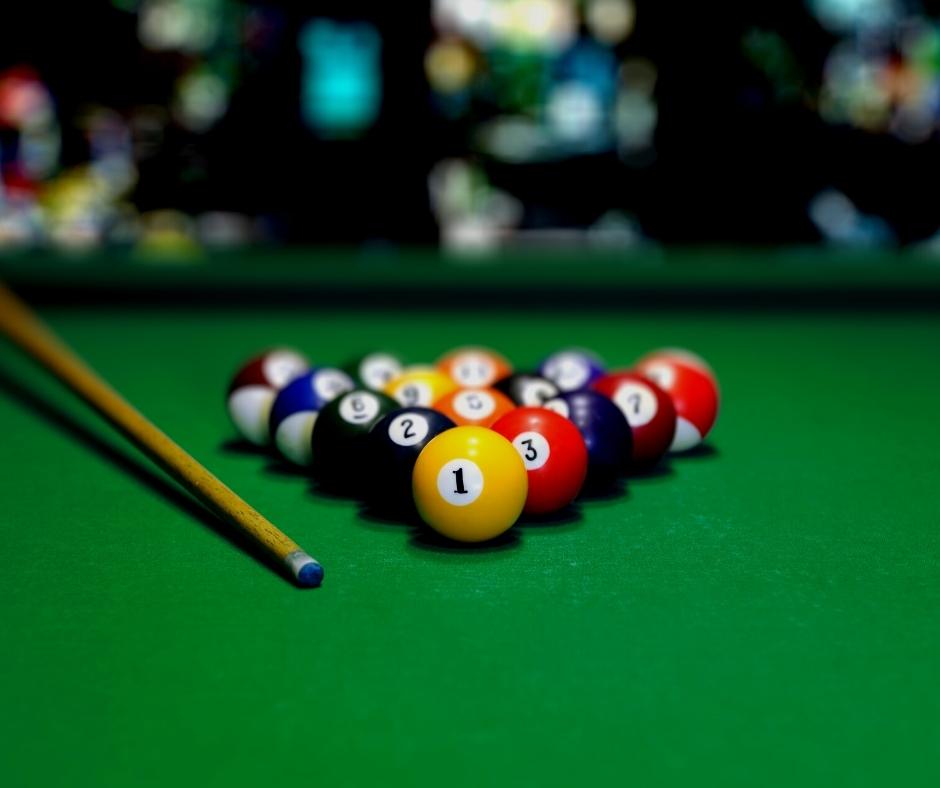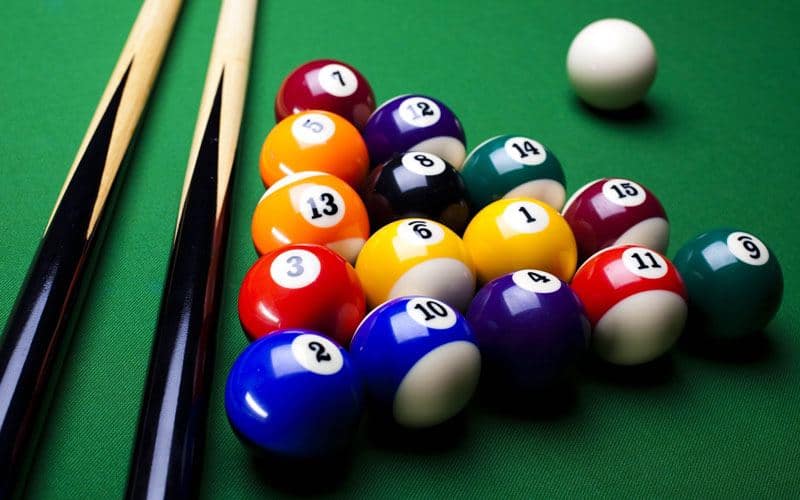Welcome to the definitive guide on mastering the game of 8 ball pool. Whether you’re a novice looking to understand the basics or an experienced player aiming to enhance your skills, understanding the rules is paramount.
8 ball pool rules are clear and easy. Take some notes from us and have the rules committed to memory. You could challenge anyone once you know the rules.
Just to be clear, all 8 ball pool rules that will be stated in this article will only be applied in 8 ball pool. The game consists of 16 overall balls on the table, the white cue ball, and 15 other objective balls. The objective balls will then be split into two teams, solid and stripes, the lower sets of the numbers will be all solid from 1-7 and the higher numbers will be the stripe balls from 9-15. The player that pockets their set of balls first gets to pocket the black 8 ball in their selective pocket, if done without scratching the white cue ball, that person is then the game’s victor.

Table of Contents
What Is The Proper Way To Rack In 8 Ball Pool?
The Racking is done only one time in a game, it is also the first thing done to start the game off. A rack is a triangle-shaped object used to hold the 15 balls together in a triangle-shaped formation. In that formation, the 8 ball should be in the direct centre of the racked balls, you should be able to count from 1-3 from either the top of the racked balls or the bottom and the 8 ball should be in the middle of that row in with you would both reach the third row.
Depending on the type of pool you’re playing the game will be racked differently, it can be in a strip then a solid formation, or a solid at one and a stripe at the other. The top of the triangle racked ball should be pointing directly at the centre of the opposite side of the table, otherwise known as the head spot where the head string or breaking point is located.
The side of the table that the balls are been racked from is called the foot spot in which we have the foot string bordered line as well.
According to 8 Ball Pool Rules, Who breaks first in the game?
The most common method of choosing which player breaks the game is to use the Lag breaking method. It is a simple method in the 8 ball pool rules. Both players will use two white cue balls that are of the same weight and size, both players will hit the ball at the same count down of play, hitting the cue ball up and down the table and whichever player’s ball is closer to the baulk cushion wins and will determine who will break the game.
However, if a player scratches the pall in any pocket, they will automatically lose, if both players scratch the Lag method will be used back again. If you are at a bar or you just playing some pool with friends a simple coin toss can easily determine who breaks as well.
Executing A legal Break
The white cue ball must be behind the head string, the selective breaker should break and pocket and pocket one or more balls without scratching the cue ball. If that was done in that format the player would then proceed to another shot, however, this time around you are going to have to call the shot you are then going to make.
8 ball pool is a call-your-play-shot game, however, the only time a shot is made without you having to state the exact details of how the ball will be pocketed is when the game breaks.
According to 8 Ball Pool Rules, What are Illegal Or Foul Breaks?
If you break and pocket a few balls but the cue ball was pocked also, that’s a foul, the play would then go to the opposing player. If you break the game and no numbered balls were pocked just the cue ball, that’s a foul break as well, the opposing player then gets the opportunity to re-rack and break or continue the game as is. If breaking and a ball jump off the table that’s a foul as well and the opposing player gets to re-break or continue as well.
Even if it’s a ball in hand once the game was fouled at the breaking and no player owns a specific solid or stripe ball, no ball that is behind the string should be played, that would consider a foul shot as well.
What Happens If You Pocket The 8 Ball On The Break Shot?
This question causes the most controversies at most games but answers will solely depend on which rule you are following. There are BCA rules and APA rules and nonetheless, we have our old fashion traditional pub rules of the game as well.
- BCA Rules – Their way is once the eight ball is been pocketed at the breaking of the game the player does not win the game, that player can then ask for a re-racking of the game or for the ball to be spotted back on the table for the match to continue.
- APA – Once the 8 ball is been pocketed at the breaking of the game without Scratching the cue ball, that player will be the victor of the game.
- Pub Rules – If the 8 ball is been pocketed and the white cue ball still remains on the table, that player wins.
So now we see how it can be a bit confusing at times according to 8 ball pool rules, never the less it’s most popular is that you win once pocketed the 8 ball without scratching if you scratch you would lose as well.
What Are The Cue Ball Fouls?
There are many ways the cue ball can be fouled in the game, say you have a ball-in-hand advantage on the table, once you have spotted the ball on the table with your hand if you even slightly touch the cue ball with the tip it is going to be a foul. The only part of the cue stick that is permitted to touch the cue ball at that moment is the ferrule if done otherwise the opposing player gets a ball in hand as a result.
Any unauthorized movement of the cue ball once it’s not the ferrule of the cue stick being used to line the play will result in a foul play on the cue ball.
How To Call Your Shots in 8 Ball Pool Rules?
All shots taken on the table should be called, you should always state which selective ball will be picked at all times in the game, the only time you don’t have to call the shot is if the shot is more than obvious. If it’s a bank shot you are attempting to execute please state how many banks it will be and which ball will be pocketed and where. Fail to call your shot properly, it is going to be a miss play and the opposing player gets the advantage of the ball in hand.
According to the 8 Ball Pool Rules, what to do if the ball goes off the table?
It does not matter which ball goes off the table, all are considered foul shots in the game. The opposing player will then get a ball in hand however if that player makes a play before the ball is then been spotted back on the table, that will be a foul as well.
It is common to see that once a ball is been kicked off the table some players tend to pocket that ball after, which is an illegal call of the game as well, the ball must be spotted back on the centerline of the foot string on the table.
What Are Foul Penalty in 8 Ball Pool Rules?
A foul penalty is given in the game when the player has broken any rules that uphold the game. This is done to keep the game very competitive so a player makes as less of them as possible or the opposing player will be granted a ball-in-hand advantage. That ball-in-hand advantage will then give them the privilege to spot the ball anywhere on the table of their choosing.
What Is A Legal Win in 8 Ball Pool Rules?
A legal win occurs when a player pockets off all the balls in which they have on the table either all the solid or all stripe balls, that player then gets to pocket the eight ball in the selective pocket that they have to choose, once they have executed that without scratching the cue ball, that player is then the victor of that match.
List Of 8 Ball Pool Rules

We have listed the following 6 ball pool rules which every player should follow:
- A Player must have at least one foot on the grown before making their shot in the game or that will be considered as a foul play, giving a ball-in-hand advantage to the opposing player.
- If The opposing player interacts with the player at hand in any form way, that will be considered as a foul, if it’s even by just being too noisy beside the player at hand, it’s gonna be a foul call of distraction.
- Call all the difficult plays on the table before you make the shot.
- If a shot is made and the cue ball does not contact any ball on the table, that’s a ball-in-hand advantage for the opposing player as well.
- On the break of the game, the cue ball must be behind the head string.
- All miscue shots of the game are called scratch, and will also give a ball in hand.
- Having the advantage of a ball in hand, if you were to accidentally touch another number ball on the table while spotting the cue ball on the table, this will be considered a scratch as well giving the opposing player the ball-in-hand advantage.
- If a player attempts to do a jump shot and intentionally miscueing the ball in the air over the next ball will be a foul in the game. That play should be executed with an elevated cue striking the top half of the cue ball.
- Pocketing the opposing player’s ball is also a foul.
- Not Calling the pocket of your 8-ball last shot can result in you losing the game, even if you did not scratch unless it’s a super obvious shot, but players should get into the habit of calling all shots.
- A cue ball scratch on pocketing the 8 ball will be a loss as well.
Maximizing Your 8 Ball Pool Proficiency
Now equipped with the fundamental rules and advanced strategies, you’re poised to elevate your 8 ball pool prowess. Remember, practice and strategic play are the cornerstones to excel in this thrilling game. Dive in, apply what you’ve learned, and enjoy the exhilarating journey of mastering 8 ball pool!
You can also check:
